The Voice of the Violin
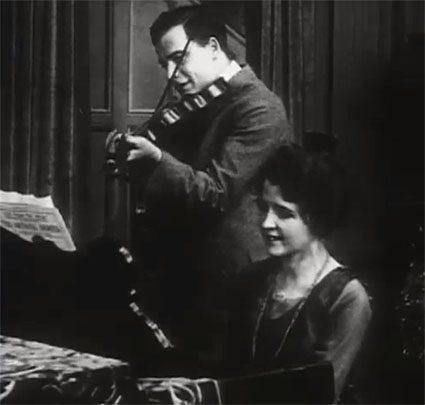
A Moving Picture Advertisement
for the Edison Diamond Disc
By Doug Boilesen, 2023
The Thomas A. Edison movie, The
Voice of the Violin, was a silent film created to promote
the the Edison Diamond Disc Phonograph in 1915.
The stars of the show were the Edison
Diamond Disc Louis XV Model B-375 Phonograph (1912 - 1915) and
the Edison Diamond Disc record "Feast of the Flowers."
This movie was intended to be used by Edison dealers and shown
in local theatres as an advertisement for the Edison Diamond Disc
and its "Re-created" music of the Edison Records. The
violin piece "Feast of the Flowers" was the Edison record
which also could have been played as part of the 'silent' movie
in addition to its important role it played in reuniting a family.
A movie of Anna Case performing
an Edison Tone Test may have also been part of the intended advertising
campaign for dealers of the Edison Diamond Disc Phonograph. Unfortunately,
that film has been lost. There is, however, a later 1926
Metropolitan opera Vitaphone short for the film "La Fiesta"
which Anna Case performing her song.
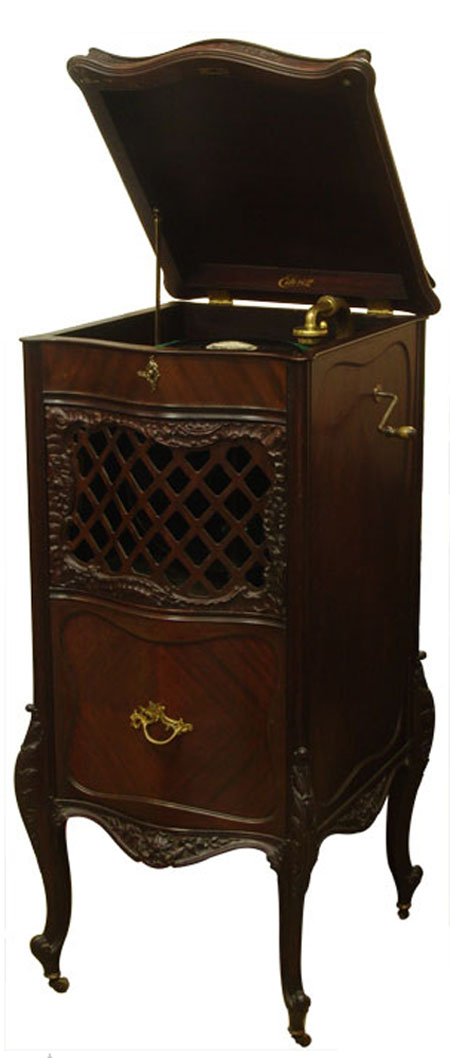
Source: The
Grammophon Museum
The following screenshots are from
"The Voice of the Violin." The 20 minute movie can be
watched using this link
to the Library of Congress digital copy.
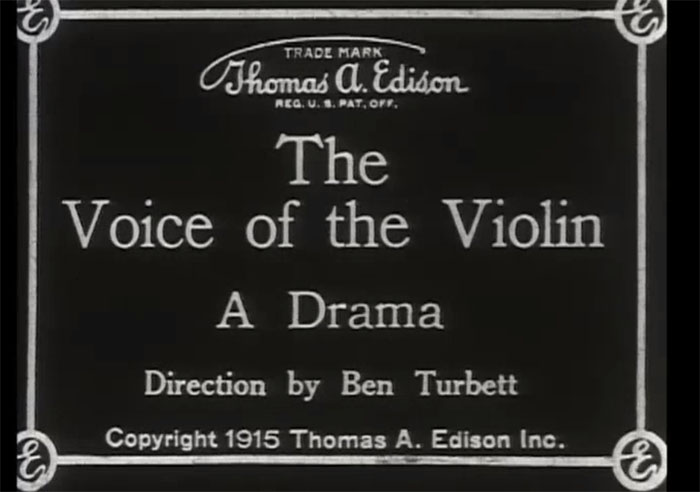
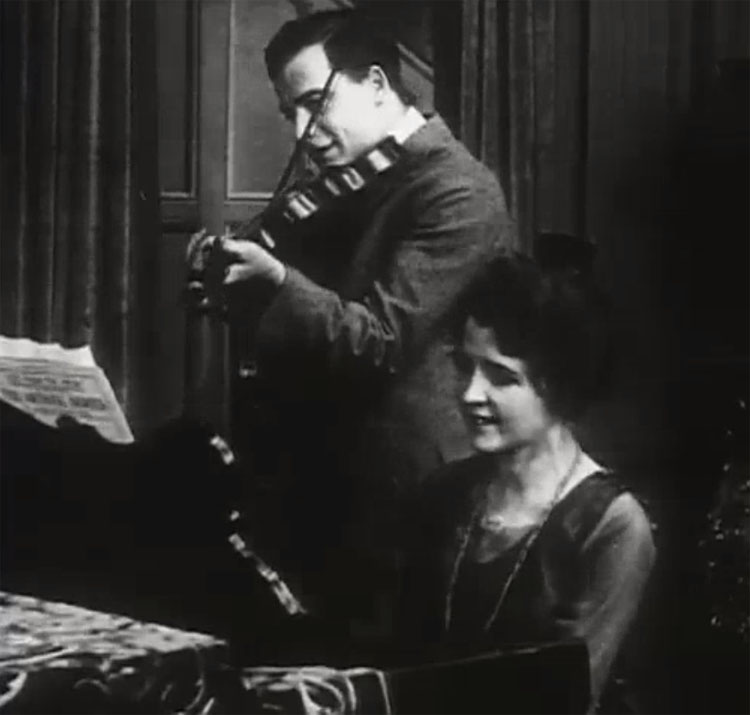
Jack McLean playing
the violin and Marjorie playing the piano at the home of Herbert
McClean Sr., Jack's father.
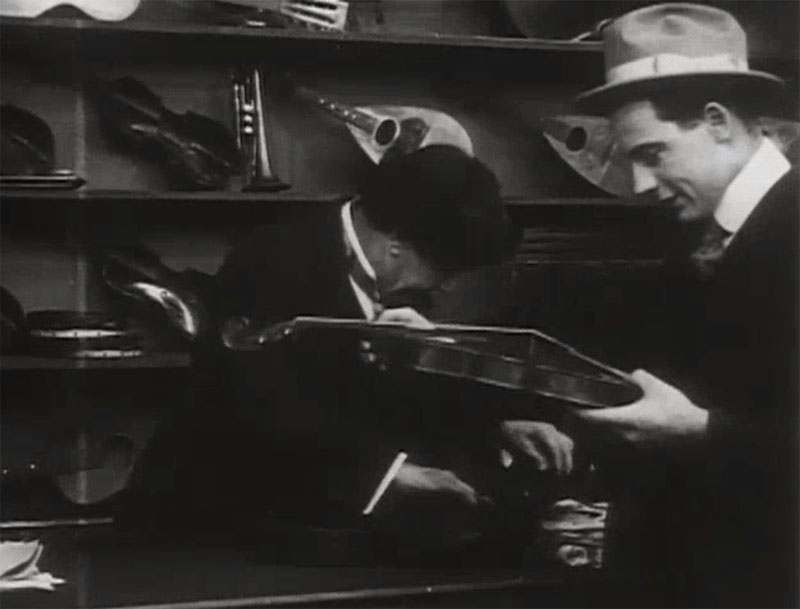
Jack McLean buys
a Stradivarious with his inheritance money. "Only $7,000."
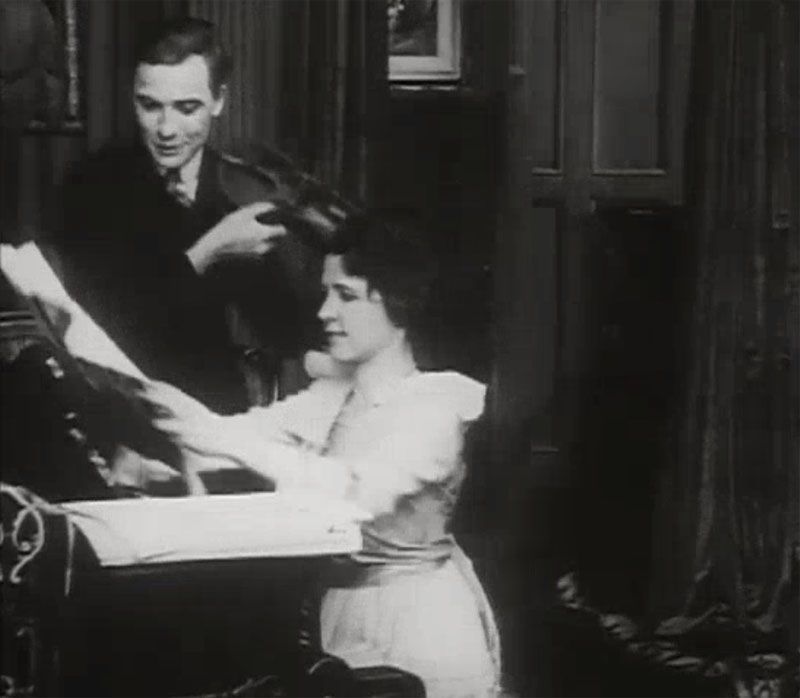
Jack returns home after
his purchase, shows Marjorie his new Strad, gives her the sheet
music "Feast of the Flowers" and they play a duet.
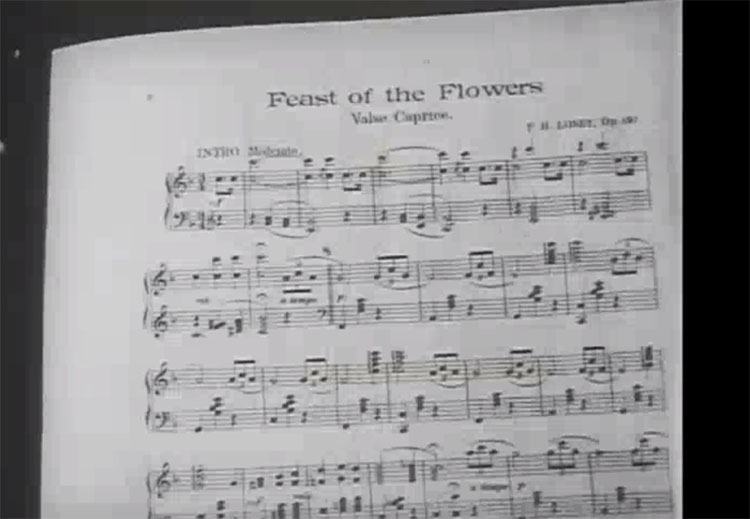
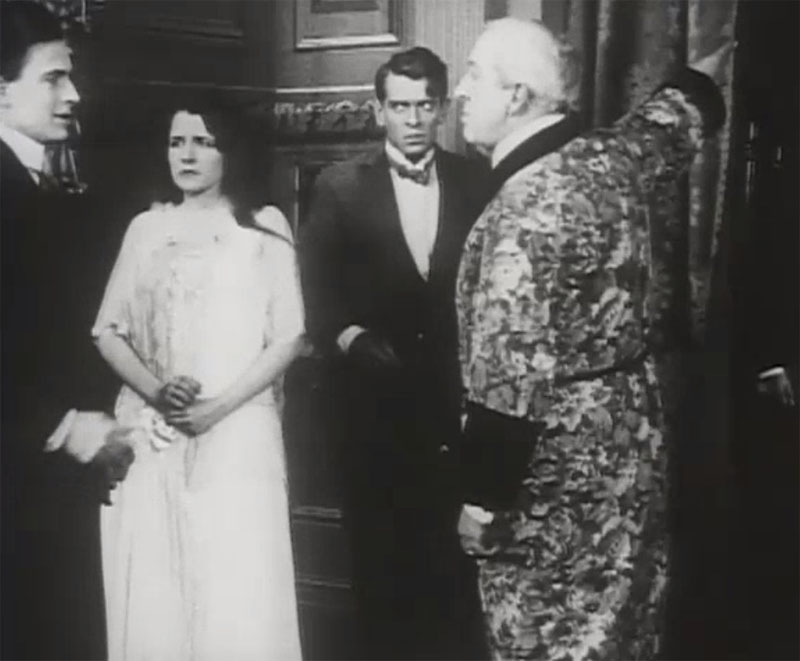
Herbert Jr. has lost
his legacy by gambling, has stolen bonds from his father, accuses
Jack of having taken the money. Herbert Sr. accordingly kicks
Jack out of the house.
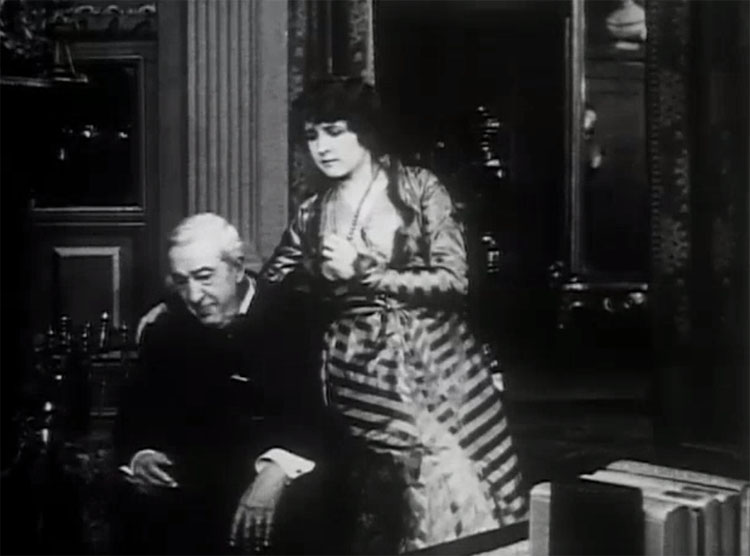
Later learning the
truth that Jack's brother Herbert Jr. was the one who stole the
money, Herbert Sr. and Marjorie searched for Jack 'using every
known means," but with no success. In despair Marjorie suggests
they should take a break from the search. "Let's go to New
York. The change will do you good."
They go to New York
City where they receive an invitation to hear the new Edison Diamond
Disc Phonograph.
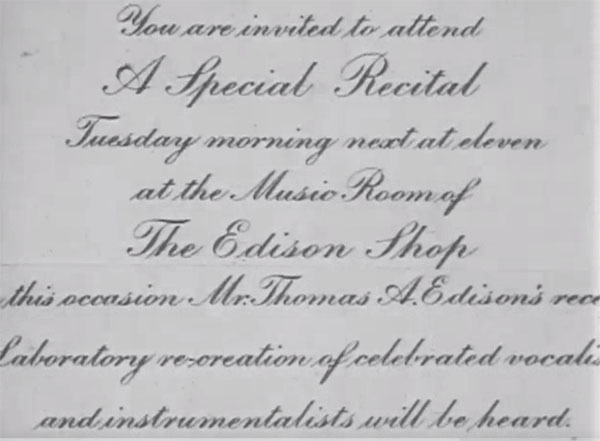
Herbert Sr. and Marjorie
accept the invitation and go to the Edison Shop for "A Special
Recital" which features its Diamond Disc Phonographs and
"No needles to change."
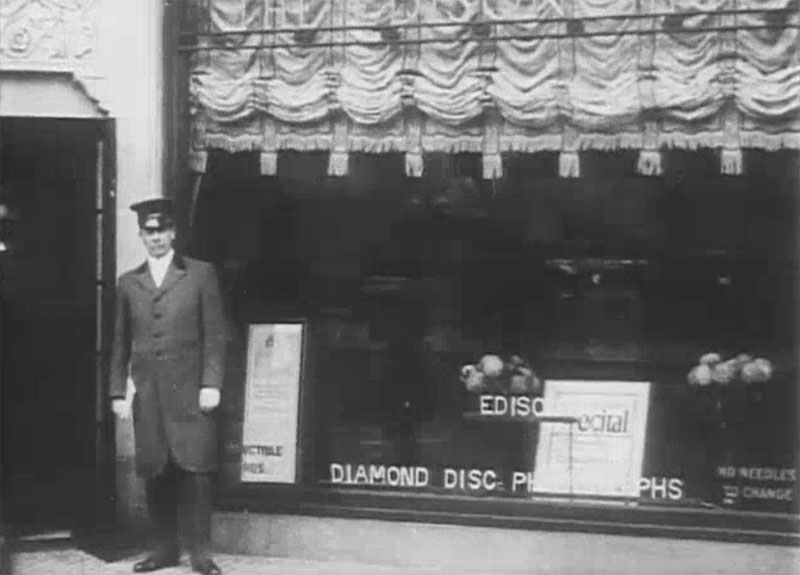
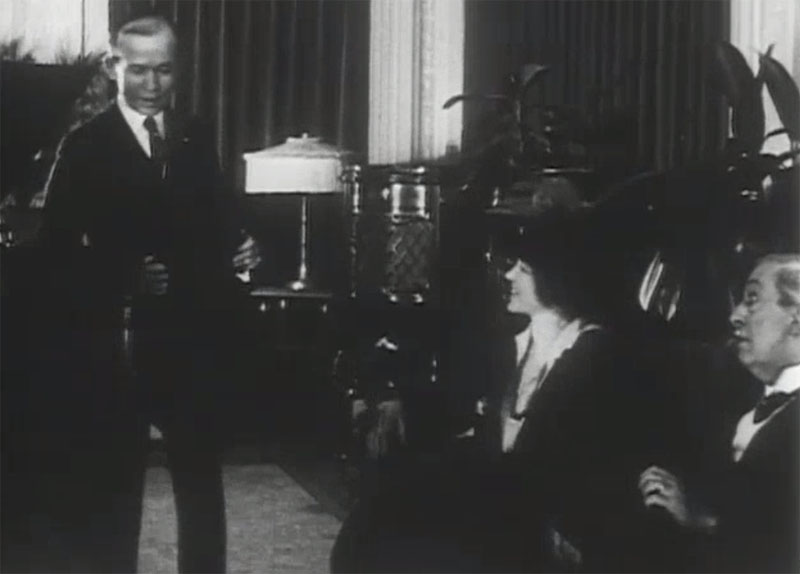
In the showroom of
the Edison Shop as the salesman prepared to a demonstrate the
Edison Diamond Disc Phonograph for Herbert McLean Sr. and Marjorie
they ask if he has the record "Feast of the Flowers?"
They do have that record
and the salesman puts it on the phonograph...and they listen.
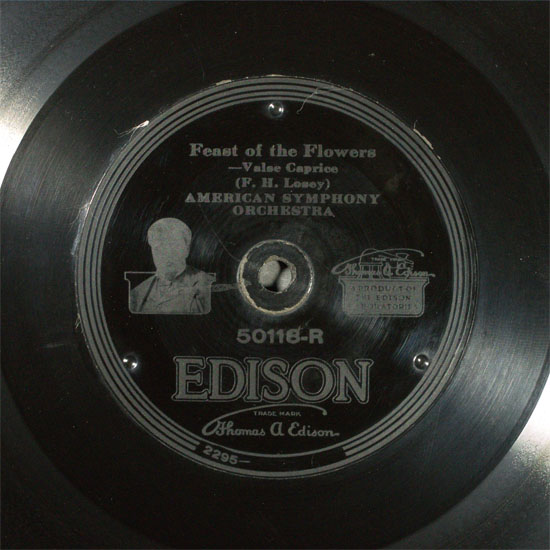
LISTEN
to "Feast of the Flowers" performed by American Symphony
Orchestra, Edison Diamond Disc Record 50118-R (Source: DAHR
and UCSB Library).
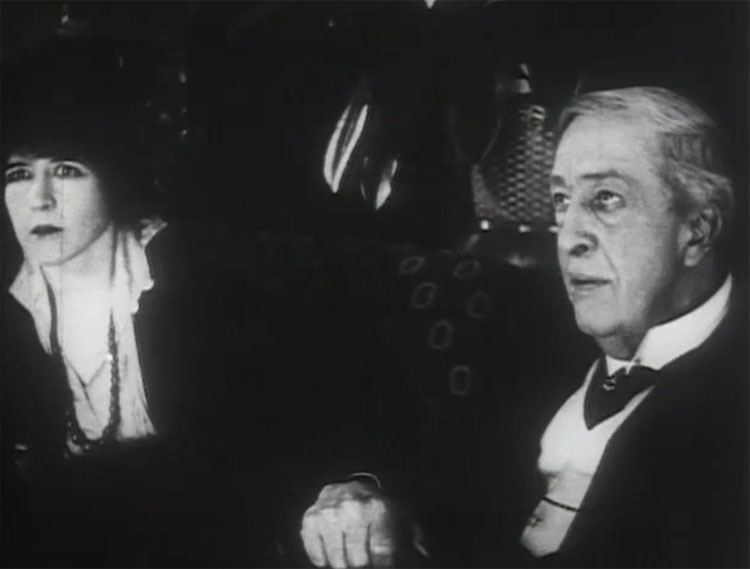
Upon hearing the record
they each visualize Jack playing that song in their home and think
that it must be Jack playing on that record.
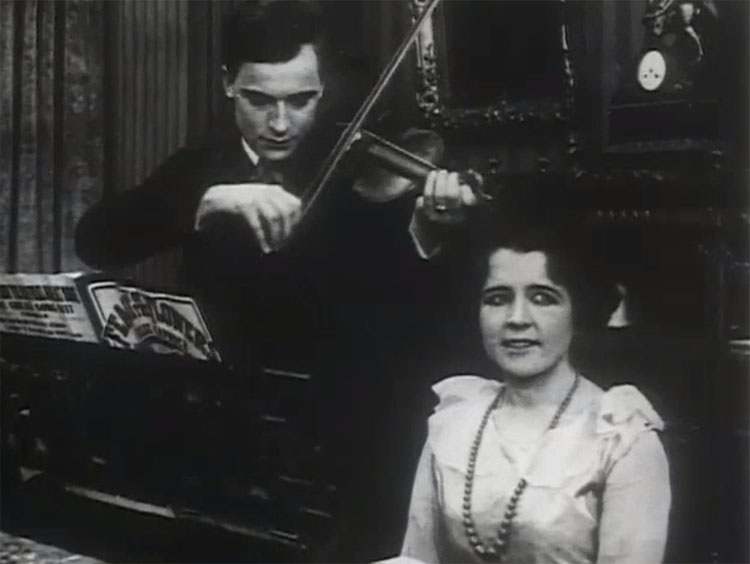
"Who is playing
first violin?" they ask. The salesman shows them the record.
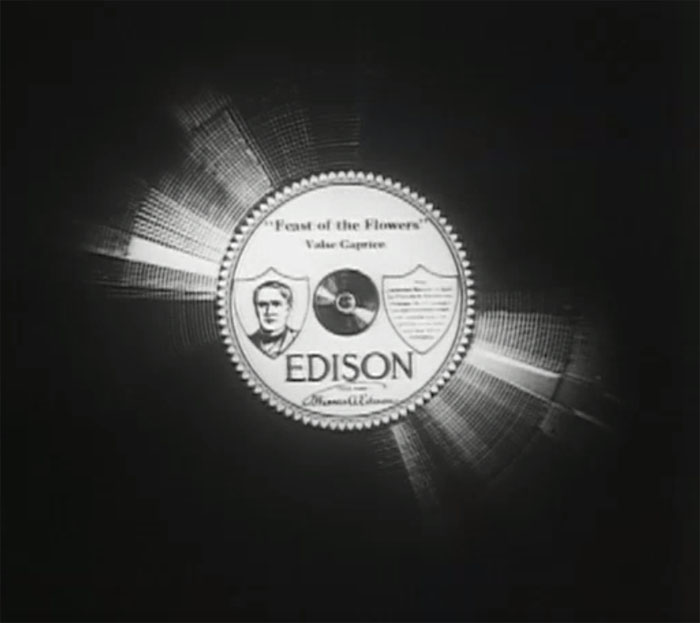
"Can you tell me
where the records are made?"
"They are made at
the Edison Recording Laboratory at Orange, N.J."
They immediately drive
to the Orange, N.J. and the Edison Laboratory.
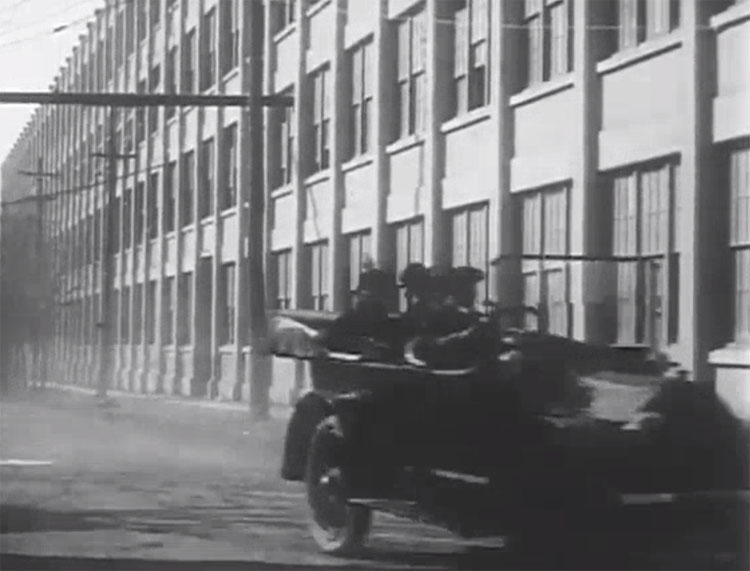
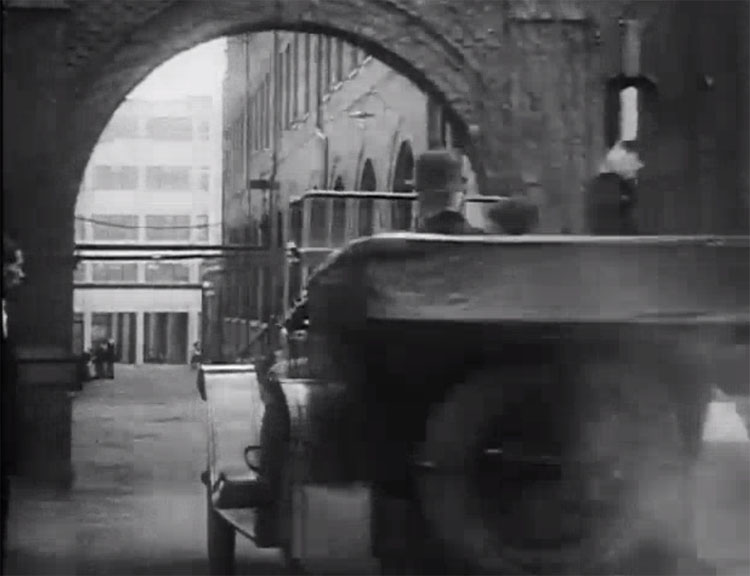
As they drive through
the factory entrance a movie intertitle explains: "These are
laboratories, not factories. The Edison Diamond Disc is the laboratory
re-creation of music, not a mere, mechanical reproduction."
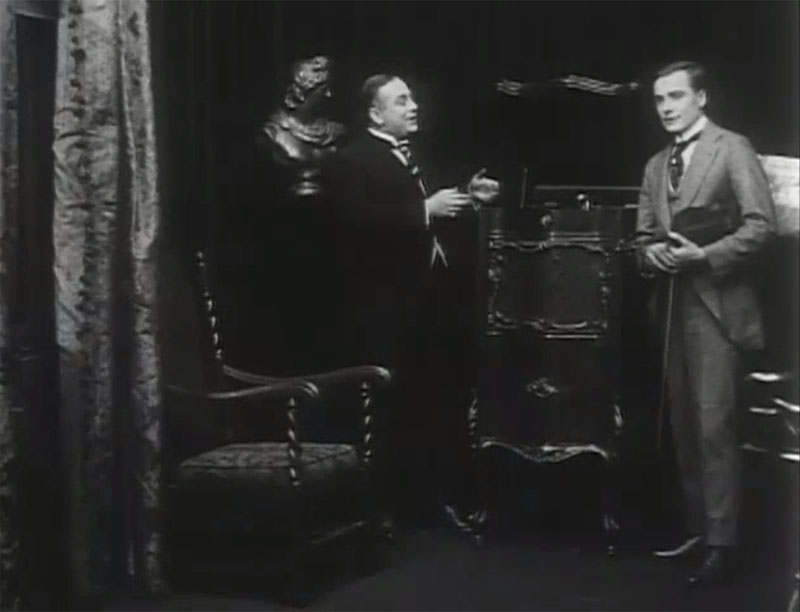
At the same time Jack,
at the invitation of a chance acquaintance, is at the Edison Music
Room at Orange, N.J. listening to the Edison Diamond Disc Louis
XV Model A-375 Phonograph.
Herbert Sr. and Marjorie
come into the same room where Jack is listening. Jack's back is
turned when they enter but he hears their voices.

They see each other and
are quickly reunited as Herbert Sr. explains what has happened and
why they are there.
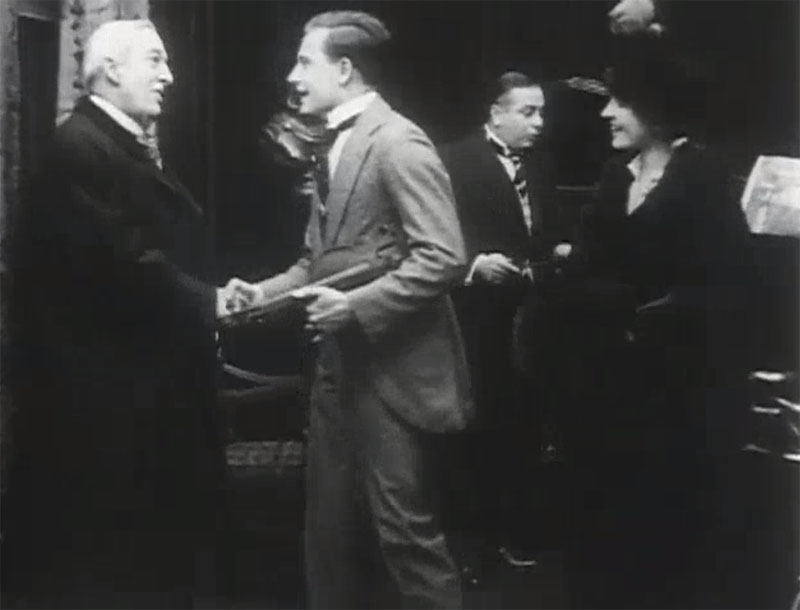
What a wonderful instrument;
what wonderful factories!" exclaims Jack.
Going to the window and
looking out at the factory buildings Jack says "In accomplishing
the actual re-creation of music by means of this new invention,
Mr. Edison spent four years of research work in acoustics and chemistry
and over two million dollars in experiments alone."
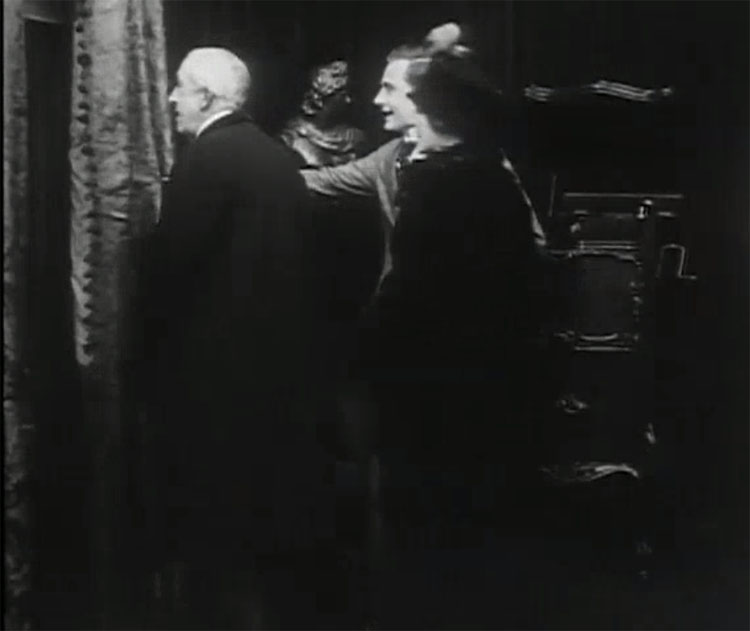
The camera again pans
the factory buildings from above, then stops on a building and tilts
down to a doorway below.
Jack, on the film's final
intertitle, says: "There he is now, Mr. Edison, himself."
The camera angle is now
street-level and from the doorway there is shown a one-second
view of Edison emerging from the door and taking a step.
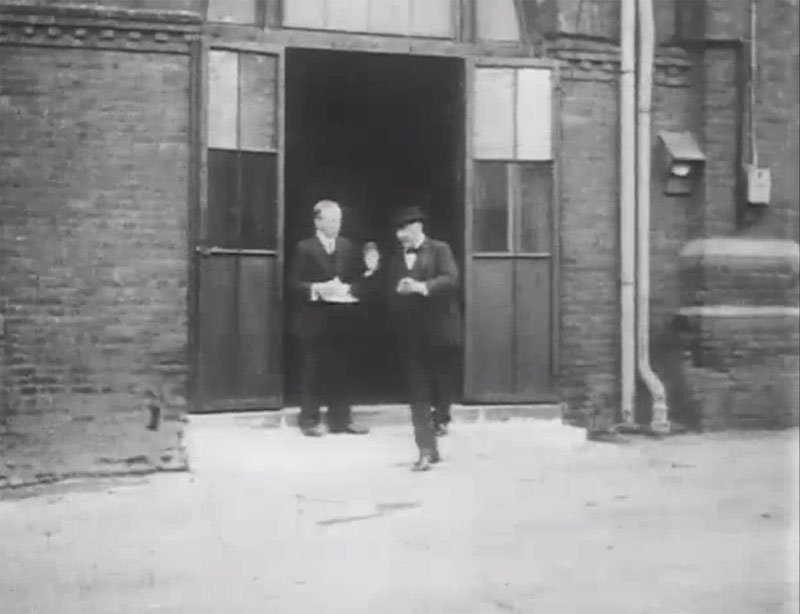
"There he is now,
Mr. Edison, himself" followed by the one-second view of Edison
in "The Voice of the Violin."
The film ends after that
'one second' and the audience is left with the image of Edison and
his association with the Re-creation of music records and his new
Edison Diamond Disc Phonograph. There may have been more steps taken
but that is all that has survived so the "one second"
appearance has been assigned by Friends of the Phonograph
with the distinction being Edison's shortest appearance in any movie.
Although the movie was
a promotional movie for the Edison Diamond Disc Phonograph, audiences
probably enjoyed it as good entertainment -- especially for the
price.
CAST:
Marjorie played by Helen Fulton, 1894
- Unknown
Jack McClean played Pat O'Malley,
1890-1966
Herbert McClean Sr., played by Robert
Brower, 1850-1934
Herbert McClean Jr., played by Carlton
King, 1881-1932
(Source: Library of Congress and film
credits)
FACTOLA: The shortest appearance
of Edison in any movie is one second* and it was in the 1915 Edison
20-minute silent film "The Voice of the Violin." (*Note:
Edison's appearance is where the surviving copy of the movie
ends, but there may have been more which has been lost).
FACTOLA: A short drama film made
by Biograph Company New York in 1909 and directed by D. W. Griffith
was titled "Voice
of the Violin." Edison's movie has no connection with the
Biograph film and perhaps "The Voice" and "Voice"
were intentional naming distinctions (however, Wikipedia and IMDB
both identify the 1909 Biograph film as "The Voice of the Violin.")

See Phonographia's The
Phonograph, Sound and the Movies for more examples of how
the term "silent movies" needs some qualifications. Not
only did many sounds accompany these early moving pictures, a "variety
of sound strategies" were used. Large and small orchestras, organs,
pianos and living voices were the primary sources for providing sound
for the silent films. But there were also examples of the phonograph
inserting itself into a movie scene or being demonstrated by phonograph
dealers in movie theatres, one of those being "The Voice of the
Violin."
Helen Fulton,
1894 - Unknown.
David Bowers has the
best biography of Helen
Fulton who seems to have disappeared after 1918.
Movies where Helen Fulton
appeared:
"Vanity Fair," as Amelia
Sedley, 1915 silent film drama produced and released in October
by the Edison Company.
"The Voice of the Violin,"
as Marjorie, 1915, the Edison Company.
"The Unpardonable Sin,"
as Julia Landis, released on June 28, 1915 by World Film Corporation.
""The Coward's Code"
with Helen Fulton as Alice Gordon, 1916
"The Picture of Dorian Gray,"
as Evelyn, released July 29, 1915.
"Mercy on a Crutch," as
Mercy Tanner, released July 13, 1915. Thanhauser Film Corporation
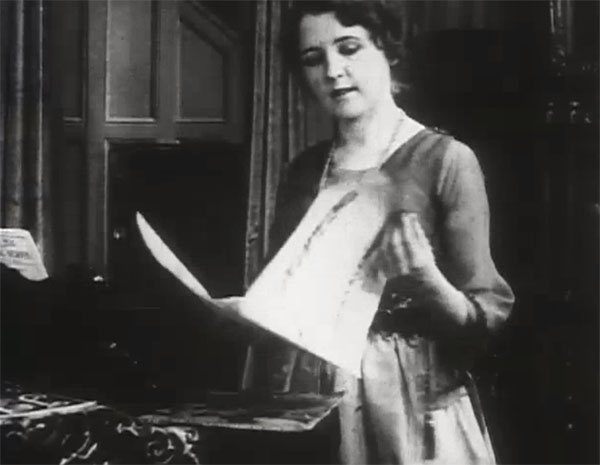
Helen Fulton as Marjorie,
Voice of the Violin, 1915
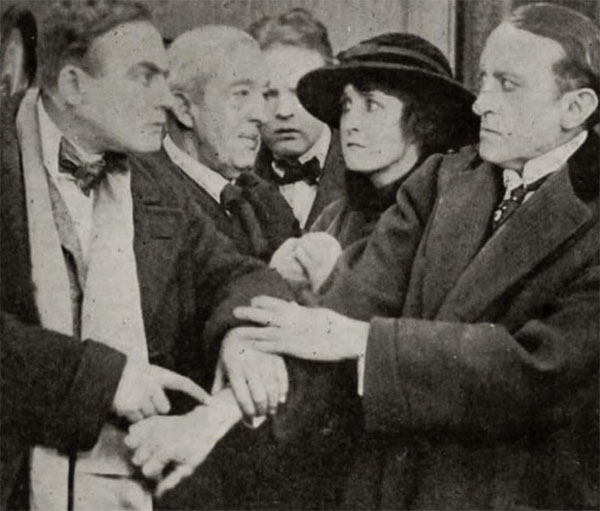
""The Coward's
Code" with Helen Fulton as Alice Gordon, 1916
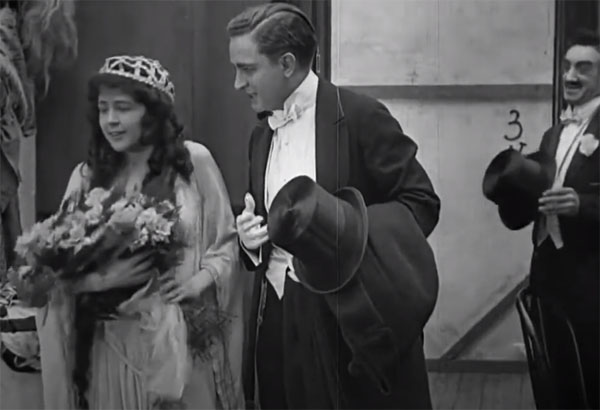
"The Picture
of Dorian Gray," as Evelyn, released July 29, 1915.
The following are a few other details
about Helen Fulton uncovered by Friend of the Phonograph
Wendy Shaw.
The earliest mention of Helen Fulton
as an actress was in 1910 (16 years old ) with Mrs. Fiske's Manhattan
Company.
In 1921, she was one of a group of
American women honored by The Italian Red Cross.
The last mention of her as an actress
was in 1917. In 1918, she was active in attempting to establish
a National Anthem Day and organizing a celebration in NYC for the
anniversary of the writing of the Star Spangled Banner (see below
for complete article in Musical America, September 28, 1918.
Helen Fulton is featured
in "Musical America," September 28, 1918 in an article
titled "Helen Fulton,
Whose Idea Set New York A-Singing the "Star-Spangled Banner."
Perfected Plans in Two Weeks -- Other Cities Eager to Follow Metropolis'
Lead" (Transcription
below - See original article here).
"Helen Fulton, Whose Idea
Set New York A-Singing the "Star-Spangled Banner."
"When the first observance
of National Anthem Day set everyone in New York singing the "Star
Spangled Banner" on the one hundred and fourth anniversary
of the writing of the song, Sept. 14, the public probably did
not realize that behind it all was just one person, the same indomitable
Helen Fulton who has already done a big bit for Uncle Sam. She
it was who in two weeks elaborated the plans which put a trained
singer in every theatre and motion-picture
house in the city to lead the audiences in singing the hymn, a
copy of the words of our anthem in every theater program and on
every table of every restaurant and in the windows of many shops,
such leaders as Harry Burnhart and L. Camilieri in the parks to
conduct gigantic community choruses, and Ann Fitaiu of Metropolitan
fame on the steps of the City Hall to sing the anthem from that
spot for the first time in the city's history. If it were not
for Helen Fulton, New York might never have waked as it is now
beginning to do to the fact the "Star Spangled Banner"
is one the world's most stirring songs.
As innocent of politics as a baby,
Miss Fulton took her courage in her hands and went to see Henry
MacDonald, director of tthe Mayor's Committee on National Defense.
"I showed him my plans,"
said Miss Fulton to a representative of MUSICAL AMERICA. "He
liked them and had me appointed chairman of the Mayor's national
Anthem Committee, and -- that's all. Everything went smoothly
and easily, except that I had to work pretty nearly twenty-four
hours a day to put it through, but then that's nothing."
Original Project
"My original project called
for an even larger celebrationj than that we actually had, but
the idea only occurred to me in July and it was not possible to
do everything I wanted to. However, future Anthem Days will give
us plenty of time and I expect to see my plans entirely carried
out by the end of the story.
"I wrote to Thomas F. Smith,
secretary of Tammany Hall and Congressman from my distgrict, and
asked him whether the fourteenth of September could not be set
as National Anthem Day by act of Congress. I thought it would
be splendid if we could initiate a nation-wide movement in that
way, but the time was too short -- not much more than a fortnight.
Large bodies move slowly and Mr. Smith thought we ought to try
to have National Anthem Day set by executive order instead of
by Congressional action, but even executive orders can't be commandeered.
Next year, however ---" Miss Fulton paused and the twinkle
in her eyes showed that her sigh was one of hope.
"I am particularly interested
in arranging and producing a pageant depicting the history of
the 'Star-Spangled Banner' and the customs and life of that period
in the development of the United States. Some time during November,
or perhaps as late as the holidays, that pageant is going to materialize.
Then I am preparing a patriotic movie to show the history of the
song and will have that shown in the moving-picture houses. The
stores have already begun to co-operate with us by putting a copy
of the words in every package they send out. Local Anthem Days
will continue to be observed as this first one was, with community
choruses and singing in the theaters and movie-houses."
"And Anthem Days that aren't
local?" Mis Fulton was asked. "Will there be any such
things?"
"It looks that way," she
replied with a laugh. "Hoboken, of all places, has been enthusiastic
about the scheme and the papers ask to have a day set by the Mayor
for observances like those we had here. I have received clippings
from Detroit that are just as enthusiastic and in fact the whole
country, so far as I can judge from the newspaper comments I have
seen, is eager to follow New York's example and will voluntarily
organize celebrations to impress on the popular consciousness
the importance of knowing our national anthem. There is no reason
that I can see why every man, woman and child in the United States,
American and foreign-born, should not be so familiar with the
words and music of the 'Star-Spangled Banner' that it shall in
time become the Allied Anthem to all nationalities residing in
this country. Wherever our flag is, there should our anthem be
also. In fact it should be known abroad too, just as the 'Marseillaise'
and songs of the other Allies are known here.
"I
am having several thousand postcards printed with one verse of
our song and the slogan, 'One Flag, One Country, One Anthem.'
At the side it says 'Learn Your National Anthem To-Day.' These
I am sending, at my own expense, to soldiers in the embarkation
camps. I'd like to make sure of every soldier 'over there,' and
every sailor too, having one, and I'd like to have translations
sent broadcast among our Allies, but -- where's the money to come
from? I'm no millionaire!
For Standard Version of Words
"And there's another difficulty
besides that of financial backing. Everybody has his own version
of the song. Some think we ought to say 'clouds of the fight'
instead of 'perilous fight' because when Key was an old, old man
and made an authograph copy for someone or other he made that
change from his own original text. But if we make that change
we must make others too -- for instance, 'on that shore' instead
of 'on the shore.' There's simply no stopping once you begin.
Personally, I prefer to stick to the words that were first printed
in the Baltimore Patriot, one hundred and four years ago,
for they afford a standard that leaves no room for controversy.
That is the version we have used and I expect it will be employed
by everyone who takes up the Anthem Day scheme.
"About the music, the situation
is far less satisfactory. The tune was edited by Sousa and Walter
Damrosch was only authorized for the navy and even if it had full
and unqualified government sanction we could not have used it,
for in getting things arranged at such short notice we had to
put up with whatever version our musicians happened to be in the
habit of using. I suppose
any version that might be chosen for the National Anthem Day celebrations
will probably be used everywhere, but it's going to be an awful
job to settle on one form of the tune and then put it in the hands
of all our musicians. Nothing
has yet been done about it by my committee; so far as we are concerned
the matter rests with the future."
"Have you seen anything that
would tend to show that your propaganda is bearing fruit?"
Miss Fulton was asked.
"Yes, I have indeed! Never
in my life have I heard anyone singing our national anthem as
they would 'Over There' or something like that, until Anthem Day
night when I was coming out of one of the theaters. There was
a dirty little ragamuffin on the sidewalk whistling the 'Star
Spangled Banner' just as gaily as he would a popular air.
"If every Anthem Day sets one
little boy whistling that tune I shall have been well paid for
my trouble, for what one little boy whistles another little boy
will whistle and so it will go" --
Miss Fulton waved her hand in a manner to indicate what is certainly
the case, that she has "started something." D. J. T.
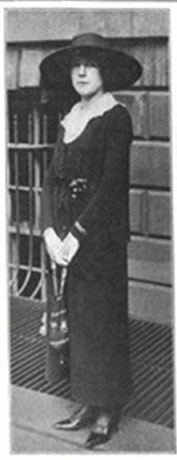
Helen Fulton, who originated National
Anthem Day, Celebrated in New York on September 14, 1918. Musical
America, September 28, 1918 (Photo by the Bain News Service)
Despite Helen Fulton's efforts (and
many others), the "Star Spangled Banner" was not made the
official national anthem until 1931.
For a brief popular culture history
of the "Star Spangled Banner" with examples of sheet
music, phonograph records, "silent" and "talking pictures,"
see Phonographia's "The
Star Spangled Banner."

Last updated January 10, 2024
|